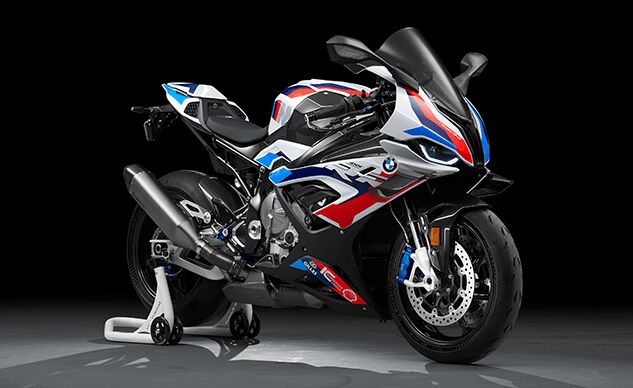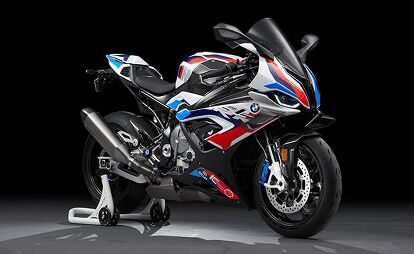2021 BMW M1000RR First Look
3 Views

BMW officially announced its first two-wheeled M model with the new M1000RR. Based on the S1000RR, no slouch on its own, the M1000RR offers a higher level of performance, adding aerodynamic wings and bumping the power output up to a claimed 212 hp while reducing the claimed curb weight to 423 pounds.

The styling takes after the S1000RR but with the addition of winglets made of clear-coat carbon fiber. The winglets help produce more downforce, counteracting wheelies while helping traction control and drive power work more efficiently.
BMW employed WSBK riders Tom Sykes and Eugene Laverty and World Endurance racer Markus Reiterberger to test the new aerodynamics on the track. Riding the M1000RR, Reiterberger lapped just 2.101 seconds behind Sykes and 1.590 seconds behind Laverty who rode their WSBK racebikes.

Like the S1000RR, the BMW M1000RR is powered by a 999cc liquid-cooled Inline-Four with the ShiftCam technology offering variable valve timing and lift. For the M model, BMW added new two-ring forged pistons from Mahle that were fortified with two additional crossbars in the box. The new pistons are also each 0.4 ounces lighter than the S1000RR’s pistons. BMW also swapped out the S1000RR’s tempered steel connecting rods with longer and lighter titanium con-rods from Pankl. This allowed BMW to increase the compression ratio to 13.5:1 from 13.3:1, while increasing the maximum engine speed to 15,100 rpm from 14,600 rpm. The ShiftCam system is similar to the S1000RR’s application, but the M1000RR makes use of a new exhaust valve spring assembly and slimmer, lighter rocker arms.
The M1000RR also uses variable intake funnels with a servomotor adjusting the length of the funnels to optimize performance, especially at high engine speeds.
The result, according to BMW, is a maximum output of 212 hp at 14,500 rpm. Peak torque remains at a claimed 83.3 lb-ft., but it arrives at 11,000 rpm, 500 rpm later than on the S1000RR. BMW claims a noticeable improvement in torque from 6,100 rpm to 9,500 rpm. For improved acceleration in all gears, BMW added a tooth to the chain sprocket, increasing it to 46.

BMW also designed a new titanium exhaust system for the M1000RR that employs two three-way catalytic converters. BMW claims the exhaust system weighs 17.2 pounds, compared to the S1000RR’s 25.2-pound system.
The M1000RR uses a modified anti-hopping clutch for improved launch control. The new clutch lacks self-reinforcing, so BMW had increase the preload force on the clutch, presumably with stiffer clutch springs, to compensate, resulting in a slightly harder lever pull.
The M1000RR offers four standard modes (Rain, Road, Dynamic and Race) plus three configurable Race Pro modes. These modes coordinate the throttle response, ABS, traction control, engine braking level and wheelie control systems. Other electronic features include a pit lane limiter, Hill Start Control Pro and BMW’s Shift Assistant Pro which allows for clutchless up and down shifts. The M1000RR can also be converted from a conventional shift pattern to a first-gear-up reverse pattern for race use.
BMW made a few changes to the chassis to optimize track performance. The steering head angle is slightly flatter than on the S1000RR, and the fork bridge offset was reduced by a few millimeters. The result is a 23.6° rake and 3.9 inches trail (compared to 23.1° rake and 3.7 inches on the S1000RR). The total wheelbase was also lengthened to 57.4 inches from 56.7 inches, thanks in part to a longer swingarm.

The rear suspension uses a revised monoshock with a fine-tuned adjustment range and a new spring. Up front, the M1000RR uses a 45mm inverted fork similar to the S1000RR’s front suspension. For the M RR, the fork bridges are milled from solid aluminum and anodized black. The fork legs were also modified to hold BMW’s custom M-branded brake calipers.

Developed from BMW’s WSBK program, the radial-mount M calipers are Nissin brakes modified for improved performance and lighter weight. The calipers are paired with dual 320mm rotors that are slightly thicker than the S1000RR’s discs. BMW offers two versions of brake pads: one for regular road use and another made from a more track-focused compound. The rear wheel uses a two-piston fixed caliper with a 220mm disc.
The M1000RR comes standard with carbon fiber wheels to reduce rotational mass. BMW claims they weigh 3.7 pounds lighter than the S1000RR’s aluminum wheels. Overall, BMW claims the 423-pound weight is 11 pounds lighter than the S1000RR.

Because it’s still a BMW, the M1000RR is available with a number of packages. The M competition package adds a GPS-powered laptrigger, silver anodized aluminum swingarm, “maintenance free” M endurance chain, and a passenger seating, pegs and seat cover. The M billet pack includes upgraded levers, footpegs, engine protectors and a brake lever guard. The M carbon package adds clear coated carbon wheels covers, chain guard and side tank covers.
The 2021 BMW M1000RR comes in a Light White/M Motorsport paint scheme. Pricing remains to be determined, but expect a sizeable premium over the S1000RR’s $17,490 MSRP.
Update: US pricing still hasn’t been confirmed but BMW Canada has priced it at CA$42,400, which is about US$31,830. By comparison, the S1000RR starts at CA$18,900.









































